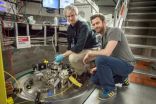The Lancet: Study reveals dramatic shortfall in donor funding for key global health issues
Just a fifth of international health aid is targeted at pandemic preparedness, research for neglected diseases like Ebola, tackling drug-resistant bacteria, and other key global health issues
2015-07-13
(Press-News.org) As the world's leaders gather in Addis Ababa, Ethiopia, for the Financing for Development Conference [1], a study published in The Lancet demonstrates that a new approach is needed for classifying funding that reflects the function the funding serves, rather than the specific disease or country. The study is the first in-depth assessment of how donor funding is spent on global versus country-specific functions of health [2].
The paper also presents an expanded definition of official development assistance (ODA) for health, which is used to identify important underfunded areas and could reshape how governments provide financial support for global health issues.
This new approach--developed by a group of leading global health experts and economists led by Dr Marco Schäferhoff, Associate Director of SEEK Development in Berlin, Germany-- provides a more complete picture of donor support. It combines both financing officially reported as ODA for health with additional spending by countries on pharmaceutical research and development for neglected diseases that disproportionately kill the world's poor, and breaks down this funding by function.
The analysis estimates that just 21% (US$4.7 of US$22.0 billion) of this funding in 2013 was devoted to global functions providing global public goods (eg, research on drugs, vaccines, and diagnostics), managing cross-border externalities (eg, preparing for the next disease outbreak and tackling antimicrobial resistance), and providing global leadership and stewardship. In contrast, 79% (US$17.3 billion) was disbursed for individual county support.
The analysis highlights the mismatch between donor support and global health needs. For example, the entire donor investment in cross-border externalities was around US$1 billion in 2013--less than a third of what the World Bank estimates the annual cost of building a pandemic preparedness system (US$3.4 billion). What is more, spending in 2013 for all global public goods (around US$3 billion) is less than half the annual US$6 billion that WHO estimates is needed to support research and development for neglected diseases alone, and is just one of many global public goods. Additionally, the researchers examined country-specific funding by country income-groups, finding that a third of aid was allocated to middle-income countries.
The authors urge governments to adopt an approach to international health financing that more strongly emphasises funding for global health functions, as these promise great impact for all countries.
Former U.S. Treasury Secretary Lawrence Summers, a co-author and Professor of Economics at Harvard University says, "The best way for donors to improve the health of poor people in middle-income countries is to invest in research and development for neglected diseases, pandemic preparedness, and other global functions of health. These investments will improve existing tools, lower drug prices, and increase global coordination to make it cheaper and more efficient for all countries to deliver health services to poor people." [3]
Dr Schäferhoff adds, "We should be investing in essential global functions, as these investments would benefit poor people wherever they live, including the poor within middle-income countries. For example, countries like China and India would substantially benefit from market shaping to lower drug prices and increased international efforts to control multi-drug resistance tuberculosis. At the same time, health aid to the world's poorest countries must continue and donor countries should also ensure that vulnerable and marginalised populations in middle-income countries, such as ethnic minorities who suffer discrimination, refugees, and people who inject drugs, receive sufficient support." [3]
INFORMATION:
NOTES TO EDITORS:
This study was funded by the Bill & Melinda Gates Foundation.
[1] Financing for Development Conference in Addis Ababa, Ethiopia, 13-16 July, 2015 http://www.un.org/esa/ffd/ffd3/conference.html
[2] Global functions are those that address transnational issues by supporting global public goods, such as research and development (R&D), managing cross-border externalities, including pandemic preparedness, and fostering global health leadership and stewardship.
[3] Quotes direct from authors and cannot be found in text of Article.
ELSE PRESS RELEASES FROM THIS DATE:
2015-07-13
As experts debate the slow response to the Ebola outbreak in West Africa and call for better international coordination, a new analysis estimates that $22 billion was spent on global health aid in 2013, yet only a fifth of this went toward such global imperatives as research on diseases that disproportionally affect the poor, outbreak preparedness and global health leadership.
The analysis, by Dean Jamison, PhD, a global health economist at UC San Francisco (UCSF); Lawrence Summers, PhD, a former US Treasury Secretary now at Harvard University; and researchers at SEEK ...
2015-07-12
ORLANDO, FL - Surgeries related to overuse elbow injuries, i.e. Tommy John Surgery, are more common among youth athletes than previously believed, according to research presented today at the American Orthopaedic Society for Sports Medicine's (AOSSM) Annual Meeting in Orlando, Florida.
"Our results showed that 15-19 year-olds accounted for 56.7 percent of the Ulnar Collateral Ligament Reconstruction (UCLR) or Tommy John surgeries performed in the U.S. between 2007-2011. This is a significant increase over time with an average increase of 9.12 percent per year," said lead ...
2015-07-12
ORLANDO, FL - Athletes who've had lower extremity surgeries before going on to play in college, might be at a higher risk for another surgery independent of gender and sport, say researchers presenting their work today at the American Orthopaedic Society for Sports Medicine's (AOSSM) Annual Meeting in Orlando, FL.
"This is the first study to look at the relationship between precollegiate surgery and future injury requiring surgery in collegiate athletes. Our results suggest that athletes injured before college might be left with a functional deficit that puts them at ...
2015-07-12
Nutrition support professionals who are well-versed in proper documentation of malnutrition diagnoses in hospital patients can help ensure that hospitals receive maximum funding for patient care according to a new review.
The review, recently published in Nutrition in Clinical Practice (NCP), a peer-reviewed, interdisciplinary journal of the American Society for Parenteral and Enteral Nutrition (A.S.P.E.N.) that publishes articles about the scientific basis and clinical application of nutrition and nutrition support, found that proper documentation and coding of malnutrition ...
2015-07-11
ORLANDO, FL - Patients treated surgically for a hamstring rupture demonstrated better results than those treated only with therapy, according to a study presented today at the American Orthopaedic Society for Sports Medicine's (AOSSM) Annual Meeting in Orlando, FL.
"Overall, patients in this study treated with surgery had a trend towards better lower extremity function as well as a higher likelihood of returning to re-injury activities than those treated non-surgically," commented corresponding author Joshua Olsen, MD, from the New England Baptist Hospital. "Most notably, ...
2015-07-11
ORLANDO, FL - Outcomes following the arthroscopic repair of rotator cuff tears in older athletes appears to be successful a majority of the time, according to research presented today at the American Orthopaedic Society for Sports Medicine's (AOSSM) Annual Meeting in Orlando, Florida.
"Seventy-seven percent of our patients who had an arthroscopic repair of a full thickness rotator cuff tear, were able to return to their sport at a similar level of intensity," said lead author, Peter Millett, MD, MSc, from the Steadman Philippon Research Institute in Vail, Colorado.
Forty-nine ...
2015-07-10
OAK RIDGE, Tenn., July 10, 2015 -- Groundbreaking work at two Department of Energy national laboratories has confirmed plutonium's magnetism, which scientists have long theorized but have never been able to experimentally observe. The advances that enabled the discovery hold great promise for materials, energy and computing applications.
Plutonium was first produced in 1940 and its unstable nucleus allows it to undergo fission, making it useful for nuclear fuels as well as for nuclear weapons. Much less known, however, is that the electronic cloud surrounding the plutonium ...
2015-07-10
Five billion years ago, a great disturbance rocked a region near the monster black hole at the center of galaxy 3C 279. On June 14, the pulse of high-energy light produced by this event finally arrived at Earth, setting off detectors aboard NASA's Fermi Gamma-ray Space Telescope and other satellites. Astronomers around the world turned instruments toward the galaxy to observe this brief but record-setting flare in greater detail.
"One day 3C 279 was just one of many active galaxies we see, and the next day it was the brightest thing in the gamma-ray sky," said Sara ...
2015-07-10
NOAA's GOES-West satellite saw that Hawaii is in the middle of a triangle of tropical cyclones. Tropical Depression 02C formed over 700 hundred miles south-southeast of Hawaii on July 10.
There are three tropical cyclones in the Central Pacific Ocean and Hawaii is in the middle of them. On July 10, newborn Tropical Depression 01C was west of Hawaii, while newborn Tropical Depression 02C was south of the Big Island. Post-Tropical Depression Ela was fizzling northeast of Hawaii.
NOAA's GOES-West satellite provided an infrared image of the newborn depression that showed ...
2015-07-10
NOAA's GOES-West satellite saw that Hawaii is in the middle of a triangle of tropical cyclones. Tropical Depression 01C formed hundreds of miles southwest of Hawaii on July 10.
There are three tropical cyclones in the Central Pacific Ocean and Hawaii is in the middle of them. On July 10, newborn Tropical Depression 01C was west of Hawaii, while newborn Tropical Depression 02C was south of the Big Island. Post-Tropical Depression Ela was fizzling northeast of Hawaii.
NOAA's GOES-West satellite provided an infrared image of the newborn depression that showed fragmented ...
LAST 30 PRESS RELEASES:
[Press-News.org] The Lancet: Study reveals dramatic shortfall in donor funding for key global health issues
Just a fifth of international health aid is targeted at pandemic preparedness, research for neglected diseases like Ebola, tackling drug-resistant bacteria, and other key global health issues


